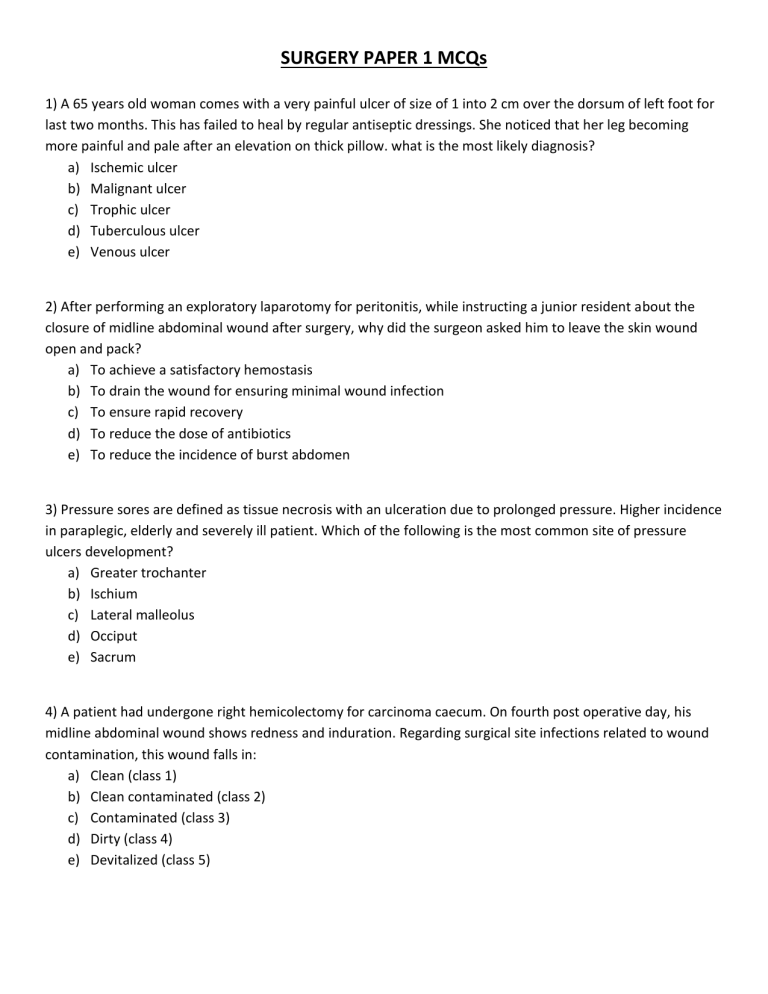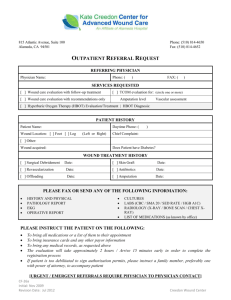
SURGERY PAPER 1 MCQs 1) A 65 years old woman comes with a very painful ulcer of size of 1 into 2 cm over the dorsum of left foot for last two months. This has failed to heal by regular antiseptic dressings. She noticed that her leg becoming more painful and pale after an elevation on thick pillow. what is the most likely diagnosis? a) Ischemic ulcer b) Malignant ulcer c) Trophic ulcer d) Tuberculous ulcer e) Venous ulcer 2) After performing an exploratory laparotomy for peritonitis, while instructing a junior resident about the closure of midline abdominal wound after surgery, why did the surgeon asked him to leave the skin wound open and pack? a) To achieve a satisfactory hemostasis b) To drain the wound for ensuring minimal wound infection c) To ensure rapid recovery d) To reduce the dose of antibiotics e) To reduce the incidence of burst abdomen 3) Pressure sores are defined as tissue necrosis with an ulceration due to prolonged pressure. Higher incidence in paraplegic, elderly and severely ill patient. Which of the following is the most common site of pressure ulcers development? a) Greater trochanter b) Ischium c) Lateral malleolus d) Occiput e) Sacrum 4) A patient had undergone right hemicolectomy for carcinoma caecum. On fourth post operative day, his midline abdominal wound shows redness and induration. Regarding surgical site infections related to wound contamination, this wound falls in: a) Clean (class 1) b) Clean contaminated (class 2) c) Contaminated (class 3) d) Dirty (class 4) e) Devitalized (class 5) 5) A 40 years old laboratory technician is suffering from ulcerative colitis develops listlessness, slurred speech, muscular hypotonia, depressed reflexes and abdominal distention. ECG shows prolonged QT interval, depressed ST segment and flattening of T wave. The fluid most appropriate for this patient would be: a) 5% dextrose b) Ringers lactate c) Normal saline with potassium replacement d) 0.9 % saline e) Dextrose saline 6) A 22 years old female got flame burns injury while operating a kitchen stove, over bilateral arms and front of chest. Over a period of few months the scars are getting abnormally raised beyond the boundary of an original wound. Regarding Keloids: a) Associated with a prolonged inflammatory phase of healing b) Commonly occurs in a triangle between both shoulder tips and xiphisternum c) Its etiology is known to be trauma to wound d) Known to occur in fair skinned people e) There is no inheritance tendency 7) 70 years old male had a history of fall on floor and got Left neck of femur fracture. He was operated and remained bed ridden for last three months. Ho developed pressure sores which on examination reveals partial thickness skin loss involving epidermis and dermis, a) Stage 1 b) Stage 2 c) Stage 3 d) Stage 4 e) Stage 5 8) A 32 years old female lactating mother presents in Surgical emergency room with fever, pain and swelling left breast for last 2 days. On examination, her left breast is red, hot, tender and swollen. She has been diagnosed with a left breast abscess. Most likely organism involved is? a) Clostridium perfringens b) Escherichia coli c) Klebsiella d) Staphylococcus aureus e) Streptococci (beta hemolytic) 9) You are tasked by your supervisor to counsel the attendant of candidate for below knee amputation. Upon query, he says indications of amputation in this patient is dead loss. What is meant by 'dead loss'? a) Gangrene of limb b) Malignancy of bone c) Paralysis and contraction d) Spreading cellulitis e) Wet gangrene 10) Outcome of below knee amputation is better or equal to above knee amputation except a) Better wound healing b) Easy walking with prosthesis c) Prosthesis held by suction d) Sufficient long stump for good leverage 11)A middle-aged man reported to your OPD with ultrasound report showing abdominal aortic aneurysm (AAA) below renal arteries. He is otherwise fit He will be advised elective repair to avoid rupture of aneurysm if its diameter is; a) > 35 mm b) > 45 mm c) > 55 mm d) > 65 mm e) > 70 mm 12) Young male of 28 years, who is heavy smoker has presented with signs of chronic limb ischemia associated with Raynaud's syndrome. i.e, aggravation of rest pain during winters. What is the diagnosis? a) Burgers' disease b) Systemic lupus erythematosis c) Polyarteritis nodosa d) Takayasu's arteritis. 13) Following is not true about anatomical parts of deep venous system of lower limbs a) Femoral vein b) Gastrocnemius vein c) Profunda femoris veins d) Soleal vein e) Two pairs of venae commitanties 14)38-year-old female presented to you with tortuous dilated veins over medial aspect of left calf and knee. She wants to know the causes of her disease. Which of the following factor has inconclusive evidence in epidemiology of disease? a) High prevalence in obese b) Increased prevalence in long standing occupation c) Increased risk during pregnancy d) Increase with age e) More common in females 15) 29 years old female, presented with gradually increasing swelling over the parietal region of scalp. Overlying skin in not mobile but swelling is mobile over deep structures. What diagnostic sign is present in most of these swellings? a) Fixity to skin b) Hemispherical shape c) Positive slip sign d) Punctum over the swelling e) Ulceration of overlying skin 16) Which of the following intravenous anesthotic drug causes hallucinations? a) Droperidol b) Ketamine c) Propofol d) Thiopental 17) The drug commonly used to treat hypotension during anesthesia is a) Atropine b) Dopamine c) Nitroglycerine d) Phenylephrine 18) Which drug should be avoided in patient who is allergic to egg a) Atracurium b) Ketamine c) Methohexital d) Propofol 19) During spinal anesthesia the spinal needle pierce through all the structures except: a) Arachnoid meter b) Durameter c) Ligamentum flavum d) Piameter 20) In epidural anesthesia the drug is injected: a) Between arachnoid and Piameter b) Between durameter and arachnoidmeter c) Between durameter and ligamentum flavum d) Between plameter and nerve fibers 21)A middle-aged male patient presented to the outpatient department with history of altered bowel habits with alternating episodes of diarrhea and constipation for the last five months. He has history of weight loss as well for the same duration. His blood complete picture Hb 8.9 gm/ dl, TLC 8 x 10°/L and ESR of 50 mm and stool routine examination shows occult blood. Chest X- ray shows fairly well-defined rounded opacities of various sizes at scattered places in both lung fields. What is the most likely diagnosis? a) Abdominal tuberculosis b) Bronchopneumonia c) Pneumoconiosis d) Pulmonary metastasis e) Sarcoidosis 22) A 20 yrs old man presents with shortness of breath and cough. A chest Xray shows a well-defined right hilar mass. CT chest shows a 4cm rounded mediastinal cystic lesion adjacent to the right side of carina with CT attenuation vale of 10 HU. No other abnormal finding seen. What is the most likely diagnosis? a) Bronchogenic Carcinoma b) Bronchogenic cyst c) Carcinoid Tumour d) Lymphoma e) Pericardial Cyst 23)Which Lung segments are separated by the superior accessory fissure? a) Apical segment of right upper lobe from other upper lobe regments b) Apical segment of upper lobe from Apical segment of lower lobe c) Apical Segments of lower lobes from other lobes segments d) Right middle lobe from Right lower lobe e) Superior segment of lingula from inferior segments of lingula 28) The cardinal features of osteoarthritis in knee joint are: a) Common in elderly females. b) Pain on activity is common. c) Require surgical treatment only. d) Varus deformity is common. 29) Radiological features in osteoarthritis are all except a) Joint space narrowing. b) Onions peel formation. c) Osteophytes formation. d) Subchondral cyst formation. 30) A patient presented to Accident and Emergency department with H/O RTA 4 hours back. He is complaining of severe pain in the neck. On examination there is decreased sensation in lateral aspect of forearm with loss of wrist extension. Which of the following neurological level is involved? a) C-5 b) C-6 c) C-7 d) C-8 e) T-1 31) A 40 years old gentleman presented with low back pain radiating to right lower leg. On clinical examination there will be following neurological signs except a) Anatomical sensory loss b) Anatomical motor loss c) Decreased Deep Tendon reflexes. d) Muscle Tremors. e) Decreased moments of spine. 32)A patient with spondylolisthesis L4-L5 level presented to OPD with no neurological loss. X-ray of lumbar spine will show a) Forward slippage of lower vertebral body on upper vertebral body b) Break in continuity of facet joint c) Backward slippage of upper vertebra on lower vertebra d) Forward slippage of upper vertebral body on lower vertebral body. e) Backward slippage of lower vertebra on upper vertebra.


